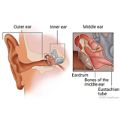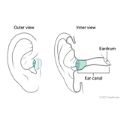Hearing Aids
Make an Appointment
Our team is here to help you make an appointment with the specialists that you need.
Hearing Aids
Overview
Hearing aids make sounds louder. There are many different styles of hearing aids. And you can add special features to your hearing aids. But almost all hearing aids have these parts:
- A microphone, to pick up sound.
- An amplifier, to make the sound louder.
- A speaker, to deliver the sound into the ear.
How to get hearing aids
If you have hearing loss and are thinking about getting hearing aids, you have some options. Your doctor or audiologist can help you get prescription hearing aids. Or you can buy hearing aids without a prescription. These are called over-the-counter (OTC) hearing aids.
Hearing aids work for people with mild to severe hearing loss. An audiologist can help you decide what type of hearing aid will work best for you. Together, you can pick a hearing aid based on the style you're looking for and the type of hearing loss you have. An audiologist can help you learn how to get the most out of your hearing aids.
OTC hearing aids are an option for people who are age 18 or older and have mild to moderate hearing loss. You don't need a hearing test to get these hearing aids, but it may be helpful to know the cause of your hearing loss. A doctor or audiologist can also help you decide if OTC hearing aids are right for you.
Personal sound amplification products (PSAPs) are another type of hearing device you can buy without a prescription. These help if you don't have hearing loss but want to make some sounds louder, such as when bird watching, listening to music, or watching TV.
Find out if your insurance covers hearing aids. They can be expensive. Different types of hearing aids come with different costs. Ask if the price includes ongoing support and service. Also find out about a warranty or return policy in case you aren't happy with your hearing aids.
How They Work
Hearing aids differ in how they look, what size they are, where they are placed in the ear, and how much they can amplify sounds.
Most hearing aids use digital technology. They are programmed for your needs using a computer. Very few hearing aids use analog technology.
The size of a hearing aid is not a good indicator of its sound quality.
There are different styles of external hearing aids. You can wear them behind your ear, in your outer ear, or in your ear canal. Hearing aids can also be completely implanted in the ear.
The kind of hearing aid you choose depends on many things, including how much hearing loss you have, your doctor or audiologist's advice, and what kind of hearing aid you want.
Special features can be added to your hearing aids to help you hear even better.
- Bluetooth.
Bluetooth technology allows you to connect your hearing aids to other electronic devices, such as cell phones, computers, and GPS devices.
- Directional microphone.
This feature can help you hear better in a noisy place. A directional microphone will make sound coming from one direction louder than other sounds. For example, a directional microphone will make a person's voice coming from in front of you louder than sounds coming from behind you. This can help you have a conversation in a noisy restaurant.
- T-coil.
A t-coil lets you switch between normal hearing aid settings and a telephone setting. This will help you hear better on a regular telephone.
- Direct audio input.
This feature lets you connect your hearing aid to a TV, radio, or cell phone. You plug it directly into your hearing aid.
- Feedback suppression.
This feature will control the high-pitched sound some people get with hearing aids (feedback). Feedback happens most when a hearing aid gets close to a telephone or if your hearing aid is loose in your ear.
Styles of Hearing Aids
Completely-in-the-canal hearing aid
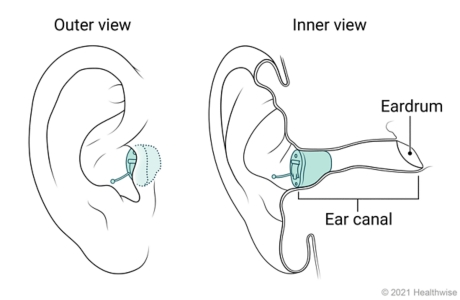
The completely-in-the-canal (CIC) hearing aid is made to fit the shape and the size of the ear canal. It fits completely into the ear canal. This hearing aid can be made with special features such as a directional microphone system that can help you hear voices in a noisy room. It can be damaged by earwax and fluid draining from the ear. CIC hearing aids are used by people who have mild to moderate hearing loss. Some people find its small size hard to handle. It's not recommended for children.
In-the-canal hearing aid
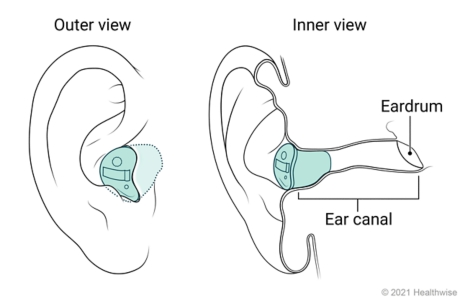
The in-the-canal (ITC) hearing aid is made to fit the shape and the size of the ear canal. It fits partly into the ear canal. This hearing aid can be made with special features such as a directional microphone system that can help you hear voices in a noisy room. It can be damaged by earwax and fluid draining from the ear. ITC hearing aids are used by people who have mild to moderate hearing loss. Some people find its small size hard to handle. It's not recommended for children.
In-the-ear hearing aid

The parts of the in-the-ear (ITE) hearing aid are in a case that fits in the outer part of the ear. ITE hearing aids can be made with special features. These include a telecoil that improves hearing during phone calls and a directional microphone system that can help you hear voices in a noisy room. An ITE hearing aid can be easier to handle than the smaller ITC and CIC hearing aids. It can be used by people who have mild to severe hearing loss. Children don't usually use them because the case must be replaced as the child grows.
Behind-the-ear hearing aid
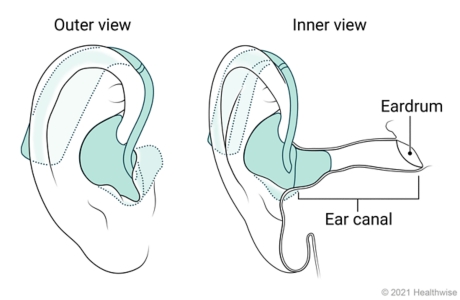
Most parts of the behind-the-ear (BTE) hearing aid are in a case that fits behind the ear. The case is connected to a plastic ear mold by a clear tube that wraps around the top of your ear. BTE hearing aids can be made with special features. These include a telecoil that helps with hearing during phone calls and a directional microphone system that can help you hear voices in a noisy room. BTE hearing aids are used for all degrees of hearing loss, especially very severe hearing loss. They may be better for children for safety and growth reasons.
Mini behind-the-ear hearing aid
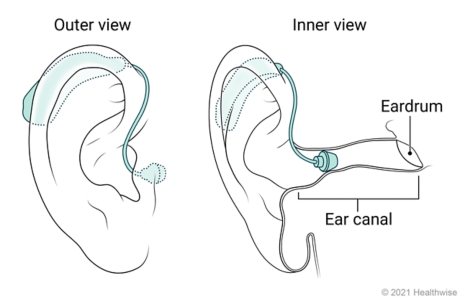
The mini behind-the-ear (BTE) hearing aid is a smaller version of the BTE hearing aid. Most of the parts are in a case behind the ear, but the case is smaller. The tube that connects the case to the earpiece is almost invisible. Some mini BTE aids have a very small earpiece that doesn't completely fill the ear canal. These are called "open fit" ear pieces. They are less visible than the ear molds used with BTE hearing aids. They also reduce the feeling of fullness in the ear and can be more comfortable to wear.
Getting Used to Them
Here are some general tips to help you adjust to your new hearing aids.
- Start by wearing your hearing aids when you are talking to only one person. These are the easiest conversations to understand. Slowly work up to conversations with more than one person.
- Continue to pay attention to people's gestures, facial expressions, posture, and tone of voice. Your hearing aids won't help you catch every word that is said, especially in a loud place.
- Wear your hearing aids. The more you wear them, especially at the beginning, the faster you will get used to them.
It may take from several weeks to months for you to get used to your hearing aids. You may find that:
- Sounds seem strange. It's good to remember that hearing aids will not make you hear like you used to. If noises are so loud and uncomfortable that they are keeping you from wearing your hearing aids, tell your hearing aid provider.
- You hear things you haven't heard in a long time. For example, you may hear background noises (rustling papers, clinking silverware) much more clearly.
- You are more aware of sounds close to you. Your footsteps, heartbeat, or car motor may be much more noticeable. With time, your brain will get better at ignoring these sounds.
- Your hearing aids can be uncomfortable. But they should not be painful. Before you leave the hearing aid provider's office with your new hearing aids, make sure they fit. Your hearing aid should not hurt your ear or be loose in your ear.
- Sometimes your hearing aids will make a buzzing noise when you use a cell phone. This noise can be annoying, and it can make it hard to hear the person on the phone. If you use a cell phone, make sure your hearing aid provider knows. Your provider can suggest hearing aids that work better with cell phones. And when you buy a new cell phone, buy one that is compatible with hearing aids.
Credits
Current as of: October 27, 2024
Author: Ignite Healthwise, LLC Staff
Clinical Review Board
All Healthwise education is reviewed by a team that includes physicians, nurses, advanced practitioners, registered dieticians, and other healthcare professionals.
Current as of: October 27, 2024
Author: Ignite Healthwise, LLC Staff
Clinical Review Board
All Healthwise education is reviewed by a team that includes physicians, nurses, advanced practitioners, registered dieticians, and other healthcare professionals.
This information does not replace the advice of a doctor. Ignite Healthwise, LLC, disclaims any warranty or liability for your use of this information. Your use of this information means that you agree to the Terms of Use. Learn how we develop our content.
To learn more about Ignite Healthwise, LLC, visit webmdignite.com.
© 2024-2025 Ignite Healthwise, LLC.
This information does not replace the advice of a doctor. Ignite Healthwise, LLC, disclaims any warranty or liability for your use of this information. Your use of this information means that you agree to the Terms of Use. Learn how we develop our content.
